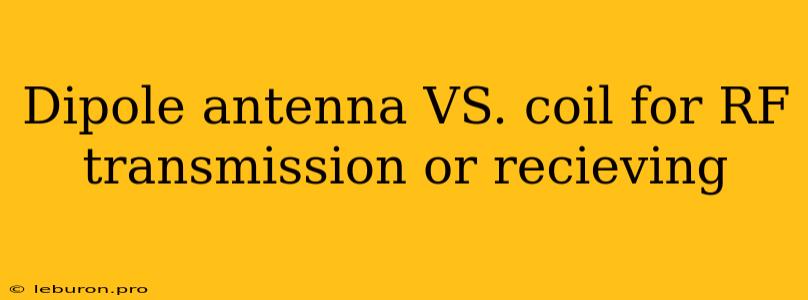The selection of an antenna for radio frequency (RF) transmission or reception is a crucial decision influenced by numerous factors, including the operating frequency, desired performance characteristics, and physical constraints. Two prevalent antenna types commonly employed in RF applications are dipole antennas and coil antennas, each exhibiting distinct advantages and limitations. This article delves into a comprehensive comparison of dipole antennas and coil antennas, elucidating their respective strengths, weaknesses, and suitability for specific scenarios.
Dipole Antennas: Fundamental Principles and Characteristics
A dipole antenna comprises two conductive elements, typically straight wires or rods, arranged in a straight line with a gap between them. This gap acts as a feed point, where the RF signal is applied or extracted. Dipole antennas are resonant antennas, meaning they are designed to operate at a specific frequency determined by their physical dimensions. The resonant frequency is inversely proportional to the length of the antenna elements.
Advantages of Dipole Antennas:
- Simple Construction: Dipole antennas are relatively straightforward to build, consisting of basic conductive elements. This simplicity makes them cost-effective for various applications.
- Wideband Operation: Compared to coil antennas, dipole antennas can operate over a broader frequency range, making them suitable for applications requiring a wider bandwidth.
- High Efficiency: Dipole antennas exhibit relatively high radiation efficiency, meaning they effectively convert electrical power into electromagnetic radiation.
- Directional Radiation Pattern: Dipole antennas radiate energy predominantly in a direction perpendicular to the antenna elements. This directional pattern can be advantageous for targeting specific receivers or minimizing interference.
Disadvantages of Dipole Antennas:
- Size Limitations: The physical length of a dipole antenna is inversely proportional to the operating frequency. At lower frequencies, the antenna length can become impractical, necessitating the use of shortened or loaded dipole antennas.
- Sensitivity to Polarization: Dipole antennas are sensitive to the polarization of the RF signal. If the signal's polarization does not align with the antenna's orientation, the received signal strength will be reduced.
- Limited Bandwidth: While dipole antennas offer wider bandwidth compared to coil antennas, they still have a limited operating bandwidth compared to other antenna types.
Coil Antennas: Exploring Their Properties and Applications
Coil antennas, also known as loop antennas, consist of a single or multiple turns of wire wound in a coil shape. The coil acts as an inductor, storing energy in a magnetic field. Coil antennas are primarily used for lower frequencies, such as in radio frequency identification (RFID) systems, wireless charging, and magnetic field sensing.
Advantages of Coil Antennas:
- Compact Size: Coil antennas can be made significantly smaller than dipole antennas at lower frequencies. This compactness is desirable in applications where space is limited.
- Low Profile: The low profile of coil antennas makes them suitable for integration into small devices or embedded within objects.
- High Sensitivity to Magnetic Fields: Coil antennas are particularly sensitive to magnetic fields, making them ideal for applications requiring magnetic field detection or generation.
Disadvantages of Coil Antennas:
- Limited Bandwidth: Coil antennas have a narrow bandwidth compared to dipole antennas. This means they are only effective over a small range of frequencies.
- Lower Efficiency: Coil antennas generally have lower radiation efficiency compared to dipole antennas, particularly at higher frequencies.
- Difficult to Match: Matching a coil antenna to a transmission line can be challenging, especially at higher frequencies.
Choosing the Right Antenna: Factors to Consider
Selecting the appropriate antenna type for a particular RF application hinges on several factors, including:
- Operating Frequency: Dipole antennas are generally more suitable for higher frequencies, while coil antennas excel at lower frequencies.
- Bandwidth Requirements: Applications requiring a wide bandwidth should consider dipole antennas, whereas applications with narrow bandwidth needs may favor coil antennas.
- Physical Constraints: Space limitations often necessitate the use of compact coil antennas, while applications with ample space might opt for dipole antennas.
- Polarization: If the polarization of the RF signal is known, a dipole antenna can be oriented accordingly for optimal signal reception.
- Performance Requirements: Factors such as radiation efficiency, sensitivity, and impedance matching must be carefully considered based on the specific application demands.
Conclusion:
Dipole antennas and coil antennas offer distinct advantages and disadvantages, making each suitable for specific RF applications. Dipole antennas excel in higher frequency applications where bandwidth, efficiency, and directional radiation are critical. Conversely, coil antennas are preferred for lower frequency scenarios where compactness, low profile, and magnetic field sensitivity are paramount.
The choice between these antennas ultimately depends on the specific application requirements and the trade-offs involved. By carefully evaluating the operating frequency, bandwidth, physical constraints, and performance requirements, engineers can make informed decisions regarding the selection of an appropriate antenna type for optimal RF transmission or reception.
